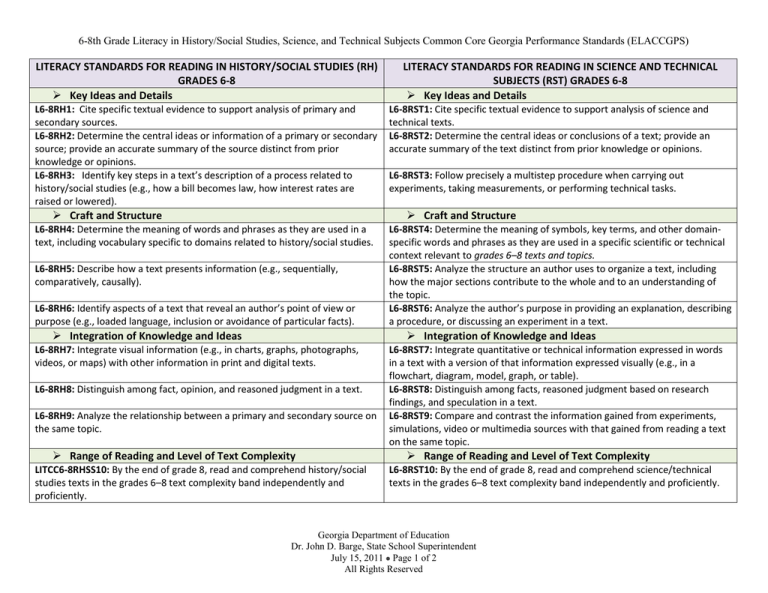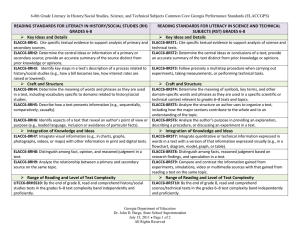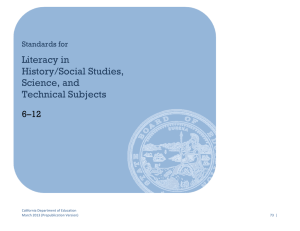
6-8th Grade Literacy in History/Social Studies, Science, and Technical Subjects Common Core Georgia Performance Standards (ELACCGPS)
LITERACY STANDARDS FOR READING IN HISTORY/SOCIAL STUDIES (RH)
GRADES 6-8
Key Ideas and Details
L6-8RH1: Cite specific textual evidence to support analysis of primary and
secondary sources.
L6-8RH2: Determine the central ideas or information of a primary or secondary
source; provide an accurate summary of the source distinct from prior
knowledge or opinions.
L6-8RH3: Identify key steps in a text’s description of a process related to
history/social studies (e.g., how a bill becomes law, how interest rates are
raised or lowered).
Craft and Structure
LITERACY STANDARDS FOR READING IN SCIENCE AND TECHNICAL
SUBJECTS (RST) GRADES 6-8
Key Ideas and Details
L6-8RST1: Cite specific textual evidence to support analysis of science and
technical texts.
L6-8RST2: Determine the central ideas or conclusions of a text; provide an
accurate summary of the text distinct from prior knowledge or opinions.
L6-8RST3: Follow precisely a multistep procedure when carrying out
experiments, taking measurements, or performing technical tasks.
Craft and Structure
L6-8RH4: Determine the meaning of words and phrases as they are used in a
text, including vocabulary specific to domains related to history/social studies.
L6-8RH5: Describe how a text presents information (e.g., sequentially,
comparatively, causally).
L6-8RH6: Identify aspects of a text that reveal an author’s point of view or
purpose (e.g., loaded language, inclusion or avoidance of particular facts).
Integration of Knowledge and Ideas
L6-8RST4: Determine the meaning of symbols, key terms, and other domainspecific words and phrases as they are used in a specific scientific or technical
context relevant to grades 6–8 texts and topics.
L6-8RST5: Analyze the structure an author uses to organize a text, including
how the major sections contribute to the whole and to an understanding of
the topic.
L6-8RST6: Analyze the author’s purpose in providing an explanation, describing
a procedure, or discussing an experiment in a text.
Integration of Knowledge and Ideas
L6-8RH7: Integrate visual information (e.g., in charts, graphs, photographs,
videos, or maps) with other information in print and digital texts.
L6-8RH8: Distinguish among fact, opinion, and reasoned judgment in a text.
L6-8RH9: Analyze the relationship between a primary and secondary source on
the same topic.
Range of Reading and Level of Text Complexity
LITCC6-8RHSS10: By the end of grade 8, read and comprehend history/social
studies texts in the grades 6–8 text complexity band independently and
proficiently.
L6-8RST7: Integrate quantitative or technical information expressed in words
in a text with a version of that information expressed visually (e.g., in a
flowchart, diagram, model, graph, or table).
L6-8RST8: Distinguish among facts, reasoned judgment based on research
findings, and speculation in a text.
L6-8RST9: Compare and contrast the information gained from experiments,
simulations, video or multimedia sources with that gained from reading a text
on the same topic.
Range of Reading and Level of Text Complexity
L6-8RST10: By the end of grade 8, read and comprehend science/technical
texts in the grades 6–8 text complexity band independently and proficiently.
Georgia Department of Education
Dr. John D. Barge, State School Superintendent
July 15, 2011 Page 1 of 2
All Rights Reserved
6-8th Grade Literacy in History/Social Studies, Science, and Technical Subjects Common Core Georgia Performance Standards (ELACCGPS)
LITERACY STANDARDS FOR WRITING IN HISTORY/SOCIAL STUDIES, SCIENCE, AND TECHNICAL SUBJECTS GRADES 6-8 (WHST)
Text Types and Purposes
L6-8WHST1: Write arguments focused on discipline-specific content.
a. Introduce claim(s) about a topic or issue, acknowledge and distinguish the claim(s) from alternate or opposing claims, and organize the reasons and evidence
logically.
b. Support claim(s) with logical reasoning and relevant, accurate data and evidence that demonstrate an understanding of the topic or text, using credible sources.
c. Use words, phrases, and clauses to create cohesion and clarify the relationships among claim(s), counterclaims, reasons, and evidence.
d. Establish and maintain a formal style.
e. Provide a concluding statement or section that follows from and supports the argument presented.
L6-8WHST2: Write informative/explanatory texts, including the narration of historical events, scientific procedures/ experiments, or technical processes.
a. Introduce a topic clearly, previewing what is to follow; organize ideas, concepts, and information into broader categories as appropriate to achieving purpose; include
formatting (e.g., headings), graphics (e.g., charts, tables), and multimedia when useful to aiding comprehension.
b. Develop the topic with relevant, well-chosen facts, definitions, concrete details, quotations, or other information and examples.
c. Use appropriate and varied transitions to create cohesion and clarify the relationships among ideas and concepts.
d. Use precise language and domain-specific vocabulary to inform about or explain the topic.
e. Establish and maintain a formal style and objective tone.
f. Provide a concluding statement or section that follows from and supports the information or explanation presented.
L6-8WHST3: (See note; not applicable as a separate
requirement)
Production and Distribution of Writing
L6-8WHST4: Produce clear and coherent writing in which the development, organization, and style are appropriate to task, purpose, and audience.
L6-8WHST5: With some guidance and support from peers and adults, develop and strengthen writing as needed by planning, revising, editing, rewriting, or trying a new
approach, focusing on how well purpose and audience have been addressed.
L6-8WHST6: Use technology, including the Internet, to produce and publish writing and present the relationships between information and ideas clearly and efficiently.
Research to Build and Present Knowledge
L6-8WHST7: Conduct short research projects to answer a question (including a self-generated question), drawing on several sources and generating additional related,
focused questions that allow for multiple avenues of exploration.
L6-8WHST8: Gather relevant information from multiple print and digital sources, using search terms effectively; assess the credibility and accuracy of each source; and
quote or paraphrase the data and conclusions of others while avoiding plagiarism and following a standard format for citation.
L6-8WHST9: Draw evidence from informational texts to support analysis reflection, and research.
Range of Writing
L6-8WHST10: Write routinely over extended time frames (time for reflection and revision) and shorter time frames (a single sitting or a day or two) for a range of
discipline-specific tasks, purposes, and audiences.
Georgia Department of Education
Dr. John D. Barge, State School Superintendent
July 15, 2011 Page 2 of 2
All Rights Reserved





